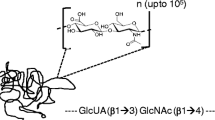Abstract.
The polysaccharide hyaluronan is an essential component of the vertebrate extracellular matrix and also produced by viruses, bacteria and fungi. Although the hyaluronan polymer is simply a disaccharide that repeats many thousands of times, it has an amazing array of biological functions and medical uses. For example, it is an efficient space filler that maintains hydration, serves as a substrate for assembly of proteoglycans and cellular locomotion, regulates cellular function and development, and is involved in tumor progression, inflammation and wound healing. Its physical properties and biocompatibility also make it of considerable importance in the development of engineered tissue, biomaterials and in clinical applications.
Similar content being viewed by others
Author information
Authors and Affiliations
Corresponding author
Additional information
Received 23 January 2007; received after revision 25 February 2007; accepted 22 March 2007
Rights and permissions
About this article
Cite this article
Almond, A. Hyaluronan. Cell. Mol. Life Sci. 64, 1591–1596 (2007). https://doi.org/10.1007/s00018-007-7032-z
Published:
Issue Date:
DOI: https://doi.org/10.1007/s00018-007-7032-z




